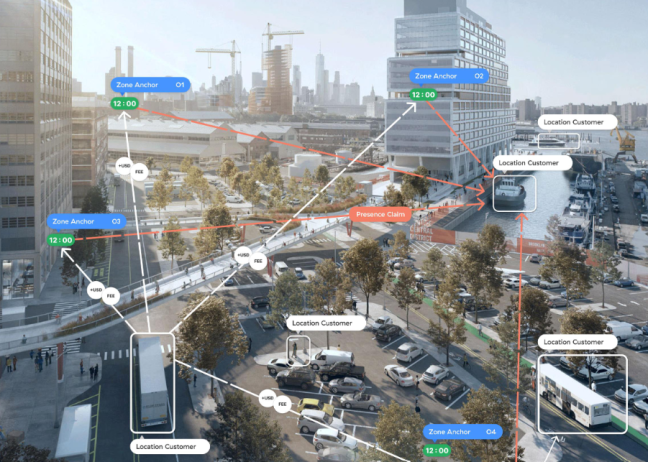Check out the recording and supporting slides for the webinar Blockchain and proof of location supporting digital government.
If you are interested in knowing more about ELISE Webinars you can find further information here.
Structure of the presentation
- What is blockchain, why it matters & fields of applications?
- EU policy context & initiatives & interoperability aspects of blockchain,
- How blockchain can enhance the location and location-enabled services?
- Location-enabled smart contracts
- Key takeaway messages and next steps
Recording
Summary of the webinar
This webinar explored the concept of blockchain and proof of location as supporting digital government and location-enabled public services. The webinar showed two roles of blockchain in the location domain, namely proof of location and the use of location data for other blockchain-enabled applications and services.

Blockchain can be used to support decentralised and privacy-friendly “proof of location” services attesting to someone or something’s presence at a certain geographic location at a certain time. The “proof of location” can be a relevant feature for smart contracts solutions. Smart contracts are agreements between two people in the form of computer code that runs on the blockchain. They can provide increased certainty, transparency and automation in transactional public services.
The first part of the webinar provided definitions and explained why blockchain matters and fields of application. For the purpose of the webinar, blockchain was defined as “a type of distributed ledger in which value exchange transactions (in bitcoin or another token) are sequentially grouped into blocks. Each block is chained to the previous block and immutably recorded across a peer-to-peer network, using cryptographic trust and assurance mechanisms”[1].
Proof of location is defined as “a digital certificate that attests someone’s presence at a certain geographic location, at a certain time”[2].
In terms of application areas, examples and benefits were briefly discussed in the sectors of financial services, insurance, public services, supply chain and sustainability.

The second section consisted of a description of the EU policy context and interoperability aspects of blockchain.

The third section tackled the concept of proof of location (see definition above.) It was emphasised that a range of public and private services require users or devices to demonstrate their location to access them or for the service to work properly. Blockchain could be the preferred option for location-based public services when there is a particular need for security and transparency.
As part of the webinar, guest speakers from FOAM[6] joined to speak about their business model based on proof of location on the blockchain. Katya Zavyalova (CCO) and Ryan King (CEO) explained that FOAM is working to provide a location service that provides secure and ubiquitous location information through blockchain. Other key features of FOAM location is their open-source standard ensuring there is “no central point of failure”, a tamper-resistant way of sharing location data and providing presence claims through digital certificates that are fraud-proof. Use cases within mobility, IoT, supply chain and location intelligence were touched upon.
The fourth section explored the use of blockchain for location applications, specifically smart contracts. A smart contract is an agreement between two people in the form of a computer code. It runs on the blockchain, and is stored on a public database and cannot be changed. In this way, smart contracts can increase the transparency, security and efficiency of issuing contracts. It was also explained that proof of location could be added as a condition in the contract code.
With regards to location-enabled services, this solution can, for example, be impactful for supply chain and land registry solutions. As a case study, a track and trace solution developed by Deloitte was presented. In Ireland, the regulator for agri-food n

Key messages and conclusions
The conclusions drawn during the webinar were the following:
- Proof of location, smart contracts and location-enabled blockchain services could bring significant benefits to the public sector and support the digital government transformation.
- The architectural setup of blockchain applications such as proof of location and smart contracts can increase trust and security.
- Continued technical and strategic work is required to support the uptake of blockchain in the public sector. This includes further work on standards, interoperability and an enabling policy environment.
- Ongoing projects explore new use-cases and possibilities, but public sector delivery at scale is yet to happen. Nevertheless, ongoing developments show clear value for citizens, businesses and public authorities.
The webinar focused on location interoperability by explaining why interoperability matters in blockchain and the current state of play in working towards standards and interoperable solutions. As mentioned, it was emphasised that there is a need for continued support to the development, uptake and dissemination of commonly agreed-upon standards for blockchain and distributed ledger technologies.
Concerning digital transformation and innovation, blockchain technology is recognised by the European Commission as one of the key emerging technologies that are shaping the future. As stated by Roberto Viola, Director-General, DG CONNECT: “Europe’s ambition is to set the gold standard for blockchain technologies. We have implemented a strong regulatory and policy framework that supports sustainable blockchain innovation as well as the start-up and scaleup ecosystems. Administrations across Europe play a trailblazing role in implementing this exciting and essential new technology.”[7]. Throughout the presentation and as part of the conclusions, the need for continued support to upscale innovation and enable large-scale uptake was emphasised.
[1] ALLESSIE D, SOBOLEWSKI M, VACCARI L, PIGNATELLI F (Editor), Blockchain for digital government, EUR 29677 EN, Publications Office of the European Union, Luxembourg, 2019, ISBN 978-92-76- 00581-0, doi:10.2760/942739, JRC115049
[2] M. Amoretti, G. Brambilla, F. Medioli and F. Zanichelli, "Blockchain-Based Proof of Location," 2018 IEEE International Conference on Software Quality, Reliability and Security Companion (QRS-C), 2018, pp. 146-153, doi: 10.1109/QRS-C.2018.00038.
[3] https://digital-strategy.ec.europa.eu/en/policies/blockchain-strategy
[4] https://www.ogc.org/projects/groups/bdltdwg
[5] https://www.iso.org/committee/6266604.html
[7] https://ec.europa.eu/digital-single-market/en/news/european-blockchain-…


Comments
Transfi Protocol is adopting the proof of location model to improve on the functionality in the transport sector. To have a full decentralized transport solution each protocol would have to work simultaneously. You can visit Transfi.net to know more about the project. You-re welcome to join the team to build the future of Transport system.